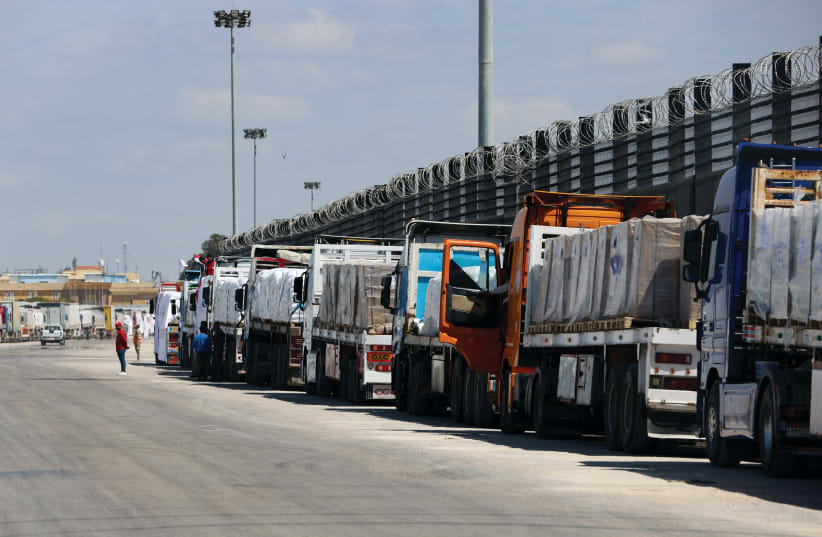The caption on the Economist’s front cover last Saturday was “Israel Alone.”
Under the caption is the photograph of a solitary dusty Israeli flag, fluttering in what looks like a sand storm, with blurred buildings in the background, allegedly somewhere in the Gaza Strip, though it is difficult to make out whether the buildings are destroyed or not, or where and when exactly the photograph was taken.
The photograph is undoubtedly very powerful, though I am not sure whether it accurately reflects Israel’s current increasingly solitary diplomatic situation.
What there is no doubt about is that for several weeks after October 7 the leaders of the enlightened world were markedly supportive of the situation Israel found itself in, after a particularly nasty attack by some 3,000 Hamas fighters/terrorists, who had crossed the allegedly impenetrable boundary between Israel and the Gaza Strip, and performed a systematic massacre, accompanied by numerous forms of war and humanitarian crimes.
The attack, for which the Israeli security forces were totally unprepared, resulted in around 1,200 civilians (most of them Israelis, but also several dozen foreigners) and military forces being killed, and 253 hostages – both living and dead – being taken across the border, into the Gaza Strip. Close to half of these are still in captivity there, awaiting release.
Of those who backed Israel at this stage, the vast majority justified a strong Israeli military reaction, involving the infliction of a deadly military and administrative blow on Hamas, and moves to bring back the hostages. The US administration went much farther than the rest, promising to provide Israel with all the arms and munitions it required, in addition to moving an American aircraft carrier and forces into the region.


HOWEVER, from the very beginning the US administration insisted that Israel start to plan the “day after,” and present a viable plan for the fighting, with minimal civilian casualties. Prime Minister Benjamin Netanyahu rejected or fudged both requests.
The result of Israel’s activities in the Gaza Strip were a massive destruction of both homes and public buildings in the city of Gaza, the forced movement of over one million civilians from northern Gaza to the center and southern Strip, creating a vast humanitarian problem of homeless, displaced Palestinians, which rapidly developed into chaos.
The number of persons killed progressively mounted to over 30,000 persons – at least a third of them children, and (according to Israel) another third active members of Hamas. Though Israel denied that it was on a vindictive journey of revenge, the world started to view the situation differently.
Israel’s original reaction to the demand for the systematic entrance of humanitarian aid into the Gaza Strip was a categorical “no” – at least until the release of all the Israeli hostages. In the face of international pressure, Israel was forced to give way, though it continued to insist on checking the content of the aid, and trying to prevent it from reaching Hamas hands. The quantity of aid progressively grew – some entering the Gaza Strip from Egypt, another part entering via Israel, and recently also from the air and the sea.
While the international community claims that there is a problem of hunger and malnutrition in the Gaza Strip, Israel argues that the situation is not as bad as that, with an extensive black market in existence, and members of hamulot (extended families) in control in certain areas. Nevertheless, it cannot be denied that the absence of an effective administrative mechanism to manage the distribution of the humanitarian aid is strongly felt.
Efforts for the release of hostages
AT THE CURRENT stage, major efforts are being made to bring back to Israel another 40 of the remaining hostages (women and children, as well as elderly, unwell or disabled men), to be followed, later on, by the remaining live and dead hostages, in return for the release of large numbers of Palestinian prisoners held in Israel, prolonged ceasefires, and additional Hamas demands, such as the immediate return of evacuees to the northern Gaza Strip, which Israel rejects out of hand.
Both the US administration and other international players are trying to get Israel to avoid a planned attack on Rafah – the last town in the Gaza Strip that Israel has not conquered, and where over one million displaced Gazans are currently living in tents and other provisional forms of shelter.
Israel is adamant in its refusal to accept the latter request, and its former supporters are starting to threaten it with sanctions, especially in the sphere of arms and munitions sales, and personal sanctions against individual Jewish settlers in Judea and Samaria (the West Bank) reported to be acting violently against Palestinians – and getting away with it by the Israeli authorities.
However, the worst deterioration concerns Israel’s relations with the American Administration in general, and between President Joe Biden and Netanyahu in particular. This deterioration is not only being affected by the presence or absence of Israeli activities in the Gaza Strip, but also by the approaching November US presidential elections, and growing dissatisfaction in Democratic circles, especially with what is viewed as Netanyahu’s ungratefulness to the US, and his alleged concern with keeping his all-Right coalition together, at almost any cost.
IN THE COURSE of this week an Israeli team, headed by Strategic Affairs Minister Ron Dermer and head of the National Security Council Tzachi Hanegbi are to travel to Washington to discuss with American officials Israel’s determination to carry out its attack in Rafah, in order to wipe out the last bastion of Hamas fighters/terrorists in the Gaza Strip. The US objects to such an attack, primarily on humanitarian grounds.
Dermer expressed the Israeli position in a Times of Israel podcast last Thursday, in which he stated: “It will happen, even if Israel is forced to fight alone. Even if the entire world turns on Israel, including the United States, we’re going to fight until the battle’s won.” Netanyahu has been speaking in a similar vein. Whether the conversations in Washington will end up preventing a total clash on this issue, is yet to be seen.
In its last issue, the Economist suggested that “there is still a narrow path out of the hellscape of Gaza” which could emerge from an agreement on a temporary ceasefire and hostage release between Israel and Hamas, and could also extricate Israel from its growing isolation.
I believe this is a rather naïve portrayal of the situation. What Israel needs in order to reverse its growing isolation is a basic change of mindset, which can only result from a change of government in Jerusalem. The Economist appears to believe that successful negotiations on a new hostage deal between Israel and Hamas could somehow lead to a change of government.
However, short of early elections, which under the current political setup seem unlikely, only an agreement between Israel and Hamas, which would be rejected by both Religious Zionism and Otzma Yehudit on ideological grounds, could bring about a change in the make-up of the government at this stage. Is Netanyahu likely to accept an agreement that will lead the leaders of the two extreme-right parties to leave the government? I doubt it.
The writer worked in the Knesset for many years as a researcher, and has extensively published both journalistic and academic articles on current affairs and Israeli politics. Her most recent book: Israel’s Knesset Members – A Comparative Study of an Undefined Job, was published by Routledge last year.
